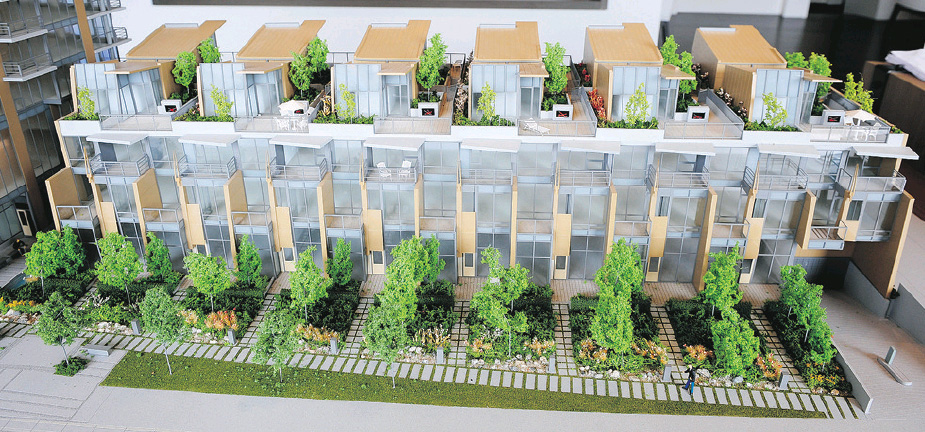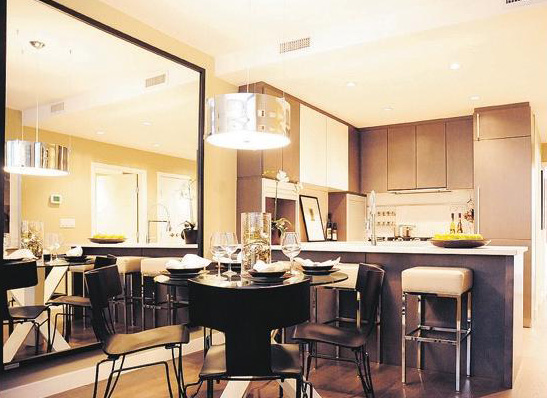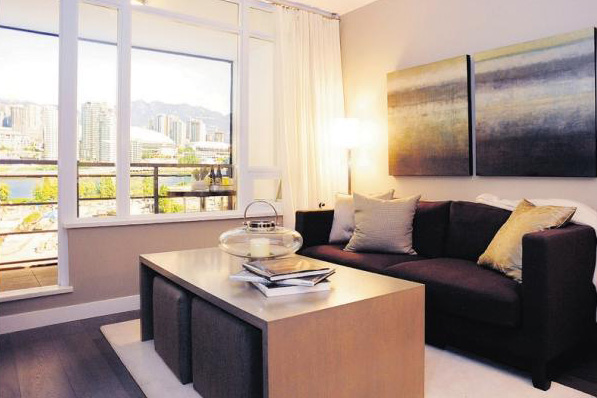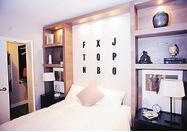Why drive when you can walk?
Mary Frances Hill
Province

The James homes will be in proximity to the seawall — and include plenty of greenery, as this model of the project demonstrates. Photograph by: Nick Procaylo, PNG, The Province

The show suite kitchen has stone countertops and islands with breakfast bars. Photograph by: Nick Procaylo, PNG, The Province

The outlook from the James show suite takes in BC Place Stadium, the downtown core, and beyond to the North Shore mountains. Photograph by: Nick Procaylo, PNG, The Province

Lighting insets are built into the shelving surrounding the bed in the James show suite. Photograph by: Nick Procaylo, PNG, The Province
THE FACTS
James, in Southeast False Creek
WHAT: 155 homes
WHERE: 290 West 1st Avenue, Vancouver
DEVELOPER: Cressey Development Group
SIZE: 553-1,449 sq. ft. PRICE: $379,900 -$1,299,900 OPEN: Sales centre 289 W. 2nd Avenue HOURS: noon -5 p.m. Sat -Thurs
Ruth Masterman’s car is three and a half years old, and has a mileage of 22,000 kilometres. Those figures may not seem important to most people, but as a barometer of how she lives her life, they tell an interesting story.
Every day, she and Samantha, her shepherd-husky cross, leave their home on West 1st Avenue, walk over the Cambie Bridge, into False Creek north, toward Science World and down again into her neighbourhood of False Creek south and back home.
In 2012, when she’ll move into James, a Cressey development to be built just a block east of her, the active grandmother’s community will be a little closer.
“Everything’s so convenient for me in this area,” says Masterman. As an owner at James, she’ll be a five-minute walk east to the social hub of the Millennium Water community and its grocery stores, coffee shops, banks, drugstores, and a community centre,
where she plans to take her grandchildren.
A walk even further east brings her to work at Main near Kingsway, where she owns a Curves fitness club franchise. She’ll stroll uphill south from her home to Cambie and 7th, for another retail hub surrounding Best Buy, Canadian Tire, Winners and Whole Foods on Cambie and 7th Avenue.
“When you look at other cities of the world where people want to live in proximity to each other, they don’t want that exclusionary feeling; they want a vibrant neighbourhood,” says Cameron McNeill of Mac Marketing Solutions, the organizers of the James development, which will have 155 homes.
Cressey’s goal was to incorporate the residences into what the Southeast False Creek community is becoming: a diverse neighbourhood designed to please ecologically sensitive residents who, like Masterman, would rather ditch their cars and bike or stroll along the waterfront, bring their family to parks that dot the seawall, to shop locally or zip downtown by nearby transit.
“Five years ago, [Cressey] identified this neighbourhood as the best place to live in terms of parkland, amenities and transit,” he says, referring to the Main Street-Science World SkyTrain to the east and Olympic Village Canada Line station to the west. The transit stations act as bookends to a hub of waterfront activity — a dragon boat launch, walkways and bike trails, a community centre, retail and amenities keep the Southeast False Creek seawall hopping with cyclists, pedestrians and shoppers.
Inside James’ one-bedroom and den display suite, the design is in the detail.
Kitchens come with standard task lighting, stone countertops, islands with breakfast bars. The bathrooms and master ensuites feature porcelain tile tubs and shower surrounds. dens have with frosted-glass pocket doors.
Standard built-in features designed to take advantage of every square foot of valuable urban space. Open pocket doors to the den; slide a vertical cover in a standard built-in entertainment unit to hide the television.
All owners will be able to take advantage of the “Up” Lounge, a clubhouse with a business centre, media room, sauna, steam room and yoga studio, a catering kitchen and children’s play area.
In a bid to reflect the spirit of Southeast False Creek’s plan, Cressey has also set up a co-op care share program and a gardening space for residents.
The city’s long community planning process for Southeast False Creek has attracted much attention over the last five years.
Today, it’s being praised by planners for its sustainability: a natural, rugged shoreline and a seawall links up to similar trails to Yaletown to Kitsilano and beyond.
A man-made habitat island with inter-tidal pools has inspired a rejuvenation of sea life, with spawning herring found all over the shoreline.
The neighbourhood is also becoming a hub of social and economic growth.
The circa 1930-era Salt Building, a reconstruction of the Vancouver Salt Co., a one-time salt refinery-turned-paper-shredding and recycling plant, will be converted into its third life as a community gathering place, a bakery, coffee shop, restaurant and brew pub, sitting in a courtyard shopping plaza.
McNeill says that this “is an inclusive neighbourhood.”
“It’s very vibrant, so buying here is as much about purchasing a home as it is about buying into a neighbourhood.”
© Copyright (c) The Province

